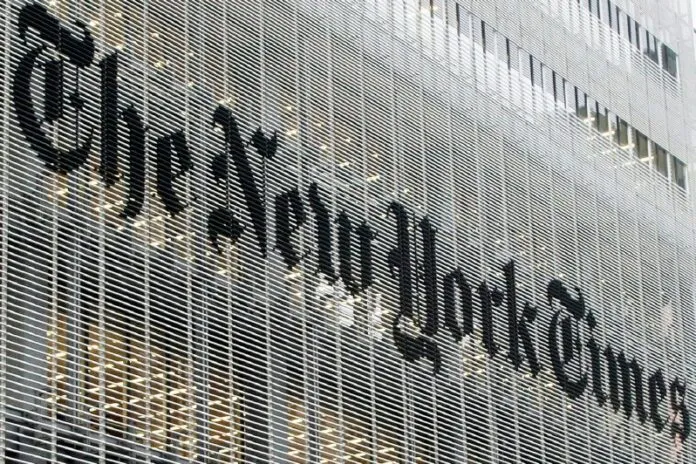The notoriously anti-Israel New York Times pushed back against claims that it had advance knowledge of the October 7th Hamas attack, releasing a letter stating that reports of photographers for the Times, CNN, AP, and others being embedded with Hamas were false.
Sen. Tom Cotton issued a call for the New York Times and other outlets to be investigated for the potential of having committed crimes by having photographers embedded with Hamas. He also demanded that the news outlets answer serious questions about what they knew about their employees accompanying Hamas during the October 7th attack.
The New York Times responded by accusing Cotton of “parroting disinformation,” insisting that “no employee of The Times was embedded with Hamas or had advance knowledge of the attack, or played any role in the savage massacre of that day.”
Sounds like a straight-up denial at first glance, but it’s not. It’s likely true that no “employee” of the Times was embedded with Hamas. However, most photographers are not by definition employees. They are third-party contractors hired by news outlets to provide them with content. In other words, the Times’ “denial” doesn’t actually deny anything.
Sen. Cotton noticed it. “What you don’t say is that your freelance photographers – pictured riding with the Hamas terrorists on 10/7 – had no advance knowledge. Is that also your claim?” he tweeted in response to the letter.
Or as Joe Gabriel Simonson of the Free Beacon wryly put it: “Contractors provide many benefits to employers, such as lower payroll taxes, savings on benefits, and plausible deniability that they are members of a terrorist organization.”
(YWN World Headquarters – NYC)











9 Responses
In other words, they bought a story (and photographs) from a free lancer, who probably also has a “day job” working for Hamas. The Times look stupid, but that has been the case for many years. And they can’t be sued.
I am considering this as a direct admission that not only were NYT assigned freelancers aware and riding along, but that management and editorial staff were aware and and engaged more freelancers in advance of the attack.
The question that I have is whether any of these freelancers actively participated or only took photos.
#ProveMeWrong #ChangeMyMind #MakeNYT-Pay
What would the times call 3 years of trump Russia collusion reporting. was that parroting disinformation, or intentionally parroting disinformation, because they knew it wasn’t true.
I can guarantee you senator cotton does not know what he’s stating not to be true.
You now know that whenever the left uses that word, they are up to no good.
The nyt shud be shot
In their defense, considering what the New York Times usually publishes, I don’t think they know the definition of truth.
The hypocritical NYT who only recently parroted islamofascistic ‘Gaza death ministry’ when Palestinians again killed Palestinians at al-Ahli hospital on Oct.17.
How can the NYT be responsible for what freelance photographers do? Supposing that a freelancer whose work appears in the NYT did know, and did ride along, and even participated, how can you leap from that to saying the NYT knew? By definition a freelancer does NOT represent his customers. Next you’ll say that if the owner of a bodega was at a Hamas rally, and I shop there, that makes me pro-Hamas?!
Milhouse. They can refuse to buy his pictures, they can refuse to do business with the free freelancer and they can condemn him.
Milhouse is correct.
Milhouse,
Neither you or I are attorneys (tough you should consider it).
You stated a legal proposition, that corporations carry no liability for the actions of their free-lance contractors.
This question was recently asked by the courts and they disagreed with your conclusion:
Lucinda Ruh v. Metal Recycling Services, LLC, Op. No. 28163 (S.C. June 21, 2023)
On June 21, 2023, the South Carolina Supreme Court settled the question of whether a principal in an independent contractor relationship may be subject to liability for physical harm proximately caused by
the principal’s own negligence in selecting the independent contractor. The Court answered in the affirmative!
The Court began its analysis by affirming the “general rule” articulated in the Court’s prior jurisprudence that a principal “is not vicariously liable for the negligent acts of an independent contractor.”
On this specific question, however, the Court clarified one point: where the principal and independent contractor are named, the plaintiff contends the independent contractor has committed a negligent act, and thus, will also be a defendant.
Like in many cases where the principal and independent contractor are both named, there are separate claims as to each. “In most cases in which the plaintiff sues the contractor and the principal … the plaintiff’s theory is the contractor’s negligence was one proximate case of the injury, but also, the principal’s negligent failure to select a competent and careful contractor was another proximate cause of the injury.”
In answering the question in the affirmative, the Court presented a history of South Carolina Court’s analysis on this question, while recognizing the question has not been squarely before the Court. The Court also noted that “every other state in the Fourth Circuit has … recognized a duty to hire a competent independent contractor.”
Indeed, “thirty-seven states have [held a principal] owes a duty [of reasonable care] in selection of an independent contractor.”
The Court went on to emphasize this point: “As our own research reveals, no state has held that a principal is insulated from the consequences of its own negligence simply because its contractor was also negligent in causing the injury.”
I agree the case is not on all fours with this situation, but it opens the door to potential litigation.
Best wishes!